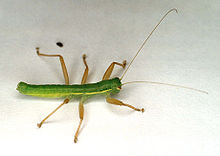Notoptera

| Notoptera Temporal range: Late Carboniferous-Present | |
|---|---|
 | |
| Mantophasma zephyra | |
| Scientific classification | |
| Domain: | Eukaryota |
| Kingdom: | Animalia |
| Phylum: | Arthropoda |
| Class: | Insecta |
| Cohort: | Polyneoptera |
| Superorder: | Notoptera Crampton, 1915 |
| Orders & families | |
| |
| Synonyms | |
| Xenonomia Terry & Whiting, 2005 | |
Notoptera, also known as Xenonomia[1] is a clade of insects belonging to Polyneoptera. It contains two living groups, Mantophasmatidae (gladiators) native to southern Africa, and Grylloblattidae (ice crawlers) native to cold montane environments in the Northern Hemisphere. Both groups are wingless.
History of research[edit]
The name was originally coined in 1915 for a group of fossil orthopteroids, and largely forgotten until it was resurrected and redefined ("Notoptera Crampton sensu novum") by Engel and Grimaldi in 2004 (after the discovery of living Mantophasmatidae), who recommended to give a single order that includes both the living and fossil representatives of the lineage.[2]
Terry and Whiting in 2005 independently proposed a new name, "Xenonomia", for the same lineage of insects (including the Grylloblattodea and Mantophasmatodea, treated as orders).[3] Some authors consider this the valid name of the order.[1]
Evolutionary history[edit]
The earliest stem-representatives of the group had emerged by the Late Carboniferous, around 320 million years ago. Early members of the group, which unlike modern notopterans had wings, have been referred to as members of "Grylloblattida" and "Reculida", with their relationships to modern notopterns historically being the subject of controversy. Winged "grylloblattidans" reached their apex of diversity during the Permian (299-252 million years ago), where they represented up to a third of all insects at some localities.[1] The earliest mantophasmatids are known from the Middle Jurassic, around 160 million years ago.[4] No fossil record of modern grylloblattids is known, though the winged Aristovia known from the Burmese amber of Myanmar dating to around 100 million years ago, has mouthparts very similar to modern grylloblattids, indicating its close relationship to modern grylloblattids. Mantophasmatids and grylloblattids are thought to have lost their wings independently. Winged "grylloblattidans" declined in diversity and abundance from the Triassic onwards, with the youngest records of winged "grylloblattidans" dating to the Early-mid Cretaceous.[1]
Gallery[edit]
- A nymph of a mantophasmatid
- Grylloblattid
See also[edit]
Further reading[edit]
- Ando H. 1982. Biology of the Notoptera. Kashiyo-Insatsu Co. Ltd., Nagano, Japan.
References[edit]
- ^ a b c d Cui, Yingying; Bardin, Jérémie; Wipfler, Benjamin; Demers‐Potvin, Alexandre; Bai, Ming; Tong, Yi‐Jie; Chen, Grace Nuoxi; Chen, Huarong; Zhao, Zhen‐Ya; Ren, Dong; Béthoux, Olivier (2024-03-07). "A winged relative of ice‐crawlers in amber bridges the cryptic extant Xenonomia and a rich fossil record". Insect Science. doi:10.1111/1744-7917.13338. ISSN 1672-9609.
- ^ Engel, Michael S.; Grimaldi, David A. (2004). "A New Rock Crawler in Baltic Amber, with Comments on the Order(Mantophasmatodea: Mantophasmatidae)". American Museum Novitates (3431). American Museum of Natural History (BioOne sponsored): 1–12. doi:10.1206/0003-0082(2004)431<0001:anrcib>2.0.co;2. ISSN 0003-0082. S2CID 85653533.
- ^ Terry, Matthew D.; Whiting, Michael F. (2005). "Mantophasmatodea and phylogeny of the lower neopterous insects". Cladistics. 21 (3). Wiley: 240–257. doi:10.1111/j.1096-0031.2005.00062.x. ISSN 0748-3007. S2CID 86259809.
- ^ Huang, Di-ying; Nel, André; Zompro, Oliver; Waller, Alain (2008-06-11). "Mantophasmatodea now in the Jurassic". Naturwissenschaften. 95 (10): 947–952. doi:10.1007/s00114-008-0412-x. ISSN 0028-1042. PMID 18545982. S2CID 35408984.



